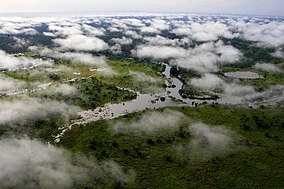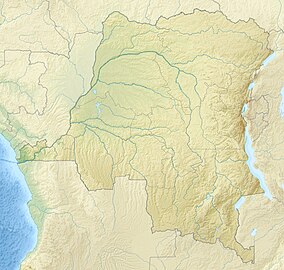Garamba National Park
| Garamba National Park | |
|---|---|
 Aerial view of the park | |
Location in the Democratic Republic of the Congo | |
| Location | Democratic Republic of the Congo |
| Coordinates | 4°0′N 29°15′E / 4.000°N 29.250°E |
| Area | 5,200 km2 (2,000 sq mi) |
| Established | 1938 |
| Governing body | |
| Type | Natural |
| Criteria | vii, x |
| Designated | 1980 (4th session) |
| Reference no. | 136 |
| Region | Africa |
| Endangered | 1984–1984; 1996–present |
Garamba National Park (French: Parc national de la Garamba) is a national park in the north-eastern Democratic Republic of the Congo covering nearly 5,200 km2 (2,000 sq mi). It is among Africa's oldest parks and was designated a World Heritage Site by UNESCO in 1980 for its protection of critical habitat for northern white rhinoceroses, African elephants, hippopotamuses, and giraffes.[1] Garamba National Park has been managed by African Parks in partnership with the Institut Congolais pour la Conservation de la Nature since 2005.
Overview
Garamba National Park was established in 1938 and covers an area of 4,900 km2 (1,900 sq mi) in northeastern Democratic Republic of the Congo. It is bounded by
History
The national park was established in 1938.[4][6]
The park was designated a World Heritage Site by UNESCO in 1980, and was included on the
African Parks' anti-poaching efforts have reportedly been successful at reducing animal deaths.[12] According to BBC, Garamba's management has been financed by the European Union and private donors.[9] Other contributors have included the United States Agency for International Development, United States Fish and Wildlife Service, Wildcat Foundation, and World Bank,[13] according to African Parks.[14]
Since 2005, the protected area is considered a
Poachers have killed at least 21 park rangers in the last decade, as of 2017, and security concerns have contributed to Garamba's struggle to establish itself as a tourist destination.[3] Joseph Kony's Lord's Resistance Army have used the park for sanctuary.[5][12][16] In 2009, the guerrilla group attacked Garamba's Nagero station, killing at least eight people, including two park rangers, and wounding an additional thirteen. Rebels also stole food and fuel, and destroyed several of the park's buildings.[12] Poachers killed five rangers and three members of the Congolese armed forces in three conflicts in 2015,[5][17] and more were killed in October.[18] In April 2016, poachers shot and killed three rangers, and wounded others (including Garamba's manager at the time),[19][20][21] and two park rangers were killed by elephant poachers in April 2017.[12][17][20] According to photojournalist Kate Brooks, who filmed in Garamba for her documentary The Last Animals, thirteen park rangers and military personnel were killed defending Garamba between January 2015 and April 2017.[22]
In 2017, National Geographic Documentary Films released The Protectors: Walk in the Rangers' Shoes, a short
Flora and fauna
The park's savannah grasslands support a low density of acacias.[5][12] Some of the Garamba's grasses can grow as high as 10 feet (3.0 m).[3]
Garamba is home to a variety of mammal species, including various species of antelope,[24] as well as buffalo, elephants, hyenas, giant forest hogs, giraffes, hippopotamus, and lions.[5][12][17] The park hosts the Democratic Republic of Congo's only remaining population of giraffes, the Kordofan subspecies, and one of the country's largest remaining populations of elephants.[5][12]
Garamba's elephants are considered a hybrid of the African savanna and African forest subspecies.[5] Poaching has reduced the park's elephant population in recent decades.[4] There were around 2,800 elephants in 2011.[4] In 2017, there were estimated to be fewer than 2,000 elephants in Garamba, a significant decline from the approximately 20,000 reported in the 1960s and 1970s.[5][3][17] 22 elephants were killed in 2012,[4] and in 2014 poachers killed 68 of Garamba's elephants within two months.[17][25][26]
Reported giraffe population sizes have varied, but show a general decline in the 90s and 00s. According to Mongabay, the population's recorded peak was 300 in 1976, and more than 100 were reported in 2008.[12] The Times said there were 356 giraffes in 1993, and only 86 by 2007.[27] The Christian Science Monitor said there were 86 in 2003 and only 38 in 2016.[28] There are 71 giraffes in the park, as of 2022. In 2024, African Parks reported over 80 Kordofan giraffes.[29] Poaching is the greatest threat to Garamba's giraffe population.[12][30]
The park once had the last wild population of the northern white rhinoceros.[5][4][10] Only fifteen northern white rhinos were reported in Garamba in the mid 1980s, prompting the park's inclusion on UNESCO's List of World Heritage in Danger.[6] In 2003–2004, there were reportedly between 20 and 25 white rhinos in the park.[31][32][33] In 2023, restoration efforts led to 16 white rhinos being moved from a private game reserve in South Africa to the park.[34]
138 mammal species and 286 bird species, including the secretarybird,[4] have been recorded in the park.[6]
Interactions between people and wild animals in and around the park has resulted in human–wildlife conflict. Local and South Sudanese poachers hunt for elephants, often in search of ivory.[12][17] Garamba's wildlife are also impacted by groups such as the Huda and Wodaabe (or "Mbororo") seeking pasture.[12]
See also
- List of largest protected areas
- List of national parks in Africa
- List of World Heritage in Danger
- List of World Heritage Sites in Africa
- Wildlife of the Democratic Republic of the Congo
References
- ^ "Garamba National Park". UNESCO World Heritage Centre. United Nations Educational, Scientific, and Cultural Organization. Retrieved 13 June 2021.
- S2CID 3495760.)
{{cite journal}}: CS1 maint: multiple names: authors list (link - ^ OCLC 643483454. Archived from the originalon 13 May 2017. Retrieved 3 October 2017.
- ^ OCLC 1645522. Retrieved 6 October 2017.
- ^ OCLC 320541675. Retrieved 3 October 2017.
- ^ ISBN 9780521615358. Retrieved 4 October 2017.
- ^ "World Heritage Committee: Eighth Ordinary Session" (PDF). UNESCO. 1984. Retrieved 4 October 2017.
- ^ "World Heritage Committee: Twentieth Session" (PDF). UNESCO. p. 32. Retrieved 4 October 2017.
- ^ a b "Prince William in plan to tackle wildlife trafficking". BBC. 15 March 2016. Retrieved 4 October 2017.
- ^ ISBN 9780761444787. Retrieved 4 October 2017.
- ^ Prunier (2004), p. 377.
- ^ a b c d e f g h i j k Nicolon, Thomas (9 May 2017). "DRC's Garamba National Park: The last giraffes of the Congo". Mongabay. Retrieved 2 October 2017.
- ^ "State of Conservation: Garamba National Park (Democratic Republic of the Congo)". UNESCO. Retrieved 4 December 2017.
- ^ "Partners: Garamba". African Parks. Retrieved 4 December 2017.
- ^ IUCN Cat Specialist Group (2006). Conservation Strategy for the Lion Panthera leo in Eastern and Southern Africa. Pretoria, South Africa: IUCN.
- ^ Chandrasekaran, Rajiv (29 October 2013). "Kony 2013: U.S. Quietly Intensifies Effort to Help African Troops Capture Infamous Warlord". The Washington Post. Archived from the original on 16 January 2015. Retrieved 9 October 2017.
- ^ OCLC 60623878. Retrieved 3 October 2017.
- ABC Online. Australian Broadcasting Corporation. 9 October 2015. Retrieved 4 October 2017.
- OCLC 185201487. Retrieved 4 October 2017.
- ^ a b "Armed poachers killing rangers who defend elephants in Congo park". CBS News. 24 May 2016. Retrieved 4 October 2017.
- ^ "African park ranger hits out at Hong Kong ivory trade". The Star. 6 June 2017. Retrieved 4 October 2017.
- ^ IAC. Retrieved 5 October 2017.
- OCLC 18030507. Archived from the originalon 13 April 2018. Retrieved 9 October 2017.
- ISBN 9782831700168. Retrieved 6 October 2017.
- OCLC 9541172. Retrieved 6 October 2017.
- ^ Min, Ariel (13 June 2014). "68 elephants killed in the last two months at African wildlife refuge". PBS. Retrieved 6 October 2017.
- ISSN 0140-0460. Retrieved 6 October 2017.
- ISSN 0882-7729. Archived from the originalon 13 April 2018. Retrieved 9 October 2017.
- ^ "Garamba National Park". African Parks. Retrieved 27 February 2024.
- ^ "KORDOFAN GIRAFFE CONSERVATION IN DRC". Giraffe Conservation Foundation. Retrieved 16 December 2020.
- OCLC 2269358. Archived from the originalon 13 April 2018. Retrieved 9 October 2017.
- ISSN 1553-8478. Archived from the originalon 13 April 2018. Retrieved 9 October 2017.
- ^ "Warning over loss of white rhino". The Irish Times. 21 May 2004. Archived from the original on 13 April 2018. Retrieved 9 October 2017.
- ^ "Making Moves to Save a Species". African Parks. Retrieved 27 February 2024.
Works cited
- Prunier, Gérard (July 2004). "Rebel Movements and Proxy Warfare: Uganda, Sudan and the Congo (1986–99)". African Affairs. 103 (412): 359–383. JSTOR 3518562.
Further reading
- De Merode, E.; Hillman-Smith, K; Nicholas, A.; Ndey, A.; Likango, M. (2000). "The spatial correlates of wildlife distribution around Garamba National Park, Democratic Republic of Congo". International Journal of Remote Sensing. 21 (13–14): 2, 665–2, 683. S2CID 3495760. Note: Published online 25 November 2010.
- Mcconnell, Tristan (18 February 2016). "Saving the wildlife 'miracle' of Congo's Garamba park". Phys.org.
- Chan, Tessa (9 June 2017). "Why Hong Kong should say no to ivory chopsticks: African park warden shot trying to stop elephant poaching appeals to city". South China Morning Post.
External links
- "Garamba". African Parks Network.
- BirdLife International. "Important Bird Areas factsheet: Garamba National Park".
- "Garamba National Park". UNESCO World Heritage Centre.
- "9 things you didn't know about Garamba". Africa Geographic. 2015.


